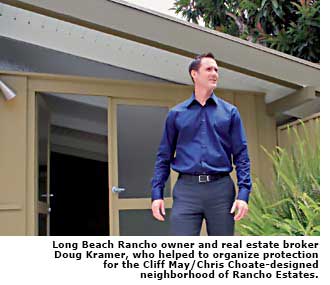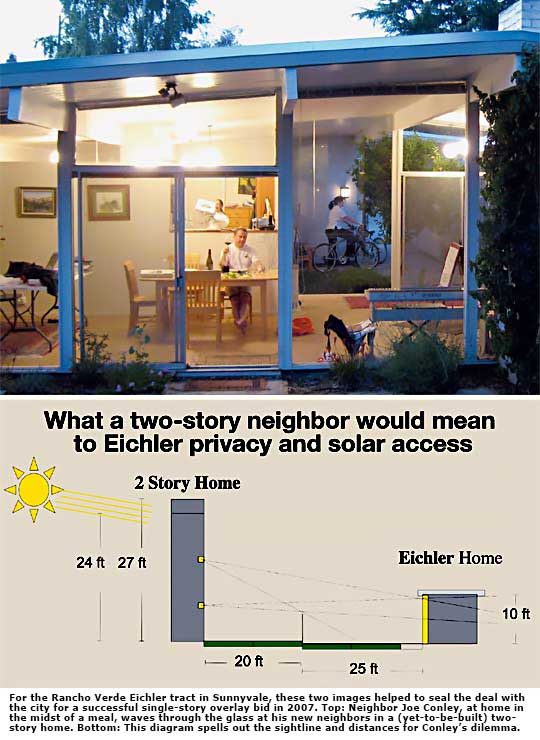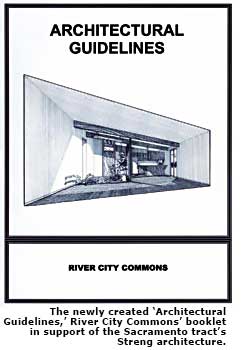Modern Preservation: Streetscape Smarts

Sometimes the realization arrives with a bang. More often it seeps into consciousness as a vague worry. What's happening to our neighborhood? Something needs to be done!
The realization burst upon the Fairhills neighborhood of Eichler homes in the city of Orange when folks discovered one morning that a neighbor had added to his home what one local called a "horrendous" 350-square-foot box. "Ohmigod! What is that?" people cried.
In the Sacramento Streng Bros. neighborhood of River City Commons, folks decided something needed to be done when things began looking tattered. Medians sprouted weeds. Fancy doors adorned with leaded glass began to replace modern, minimalist front doors.
Almost every development of modern homes sooner or later confronts the grand challenge—will our neighborhood keep its looks? Often, the answer is no. But increasingly, as mid-century modernism wins new fans, residents band together to save their neighborhoods' architectural integrity and streetscape character.
How they have succeeded can be instructive. There is, however, no one-size-fits-all solution, because circumstances, local planning rules, and local tastes differ. And preserving modern architecture comes with particular challenges.
Since it is a subtle style, modernism is all too easy to ruin, aficionados say. All it takes to destroy the looks of a Streng home, for example, is to replace the striated plywood garage door with something that has sunburst windows. Removing the distinctive globe light from the front façade in favor of something from a 19th century carriage house completes the changeover.
The other major challenge to preserving modern neighborhoods is their age. Many landmarking laws only kick in if a building is at least 50 years old.
And some residents simply cannot abide any restrictions on their ability to do with their homes what they will—even if they plan to do nothing. It's the 'my-home-is-my-castle' argument, and it's a compelling one—so much so that most advocates of architectural restrictions seek solutions that achieve the most while affecting individual choice the least. Many people share the opinion of Juka Ailio, until recently an Eichler owner in the Fairglen subdivision of San Jose, who disdains "fusspots in the neighborhood who tell you how things ought to be done."
Nonetheless, people in modern neighborhoods often decide that the pain of regulation is worth it.

Winning over the neighbors
Although there are several strategies for preserving a neighborhood, all start with one requirement: that most residents buy in. Adriene Biondo, who heads the modern committee of the Los Angeles Conservancy, says the first thing that must be done is engaging homeowners and helping them understand that their homes are architecturally significant.
Biondo, who lives in the Balboa Highlands Eichler tract of Granada Hills, has made it her crusade to spread the word throughout the San Fernando Valley, which is dotted with subdivisions designed by the firm of Dan Palmer and William Krisel and other mid-century architects. She's met with groups of neighbors, encouraged launching community websites, attended block parties, and called meetings—with some success.
Particularly useful was a Conservancy-produced tour of the Valley in 2006, 'Spectacular Vernacular.' Its impact was immense in the Palmer & Krisel-designed neighborhood of Corbin Palms, said Stacey Margolis-Sigman, who pointed out after the tour, "The fire lit." Since then, some neighbors are contemplating seeking historic designation through the city, which has a mechanism called a Historic Protection Overlay Zone.
In Palm Springs, Nat Gozzano and John Shields have raised consciousness among neighbors with a website (racquetclubestates.com) devoted to their neighborhood, Racquet Club Road Estates. The development, largely built by the Alexander Construction Company, was designed by Palmer & Krisel.

"The website is such a valuable tool to educate people and help them to understand what they're sitting on in their neighborhood," says Gozzano. People who have successfully preserved their neighborhoods through zoning or similar methods all agree on one piece of advice: proponents shouldn't insist on more than their neighbors are willing to accept. Not every modern neighborhood is inhabited by purists who want to live in a time capsule from the 1950s. And many people, even devotees of modern architecture, differ about what sorts of changes are acceptable or not.




